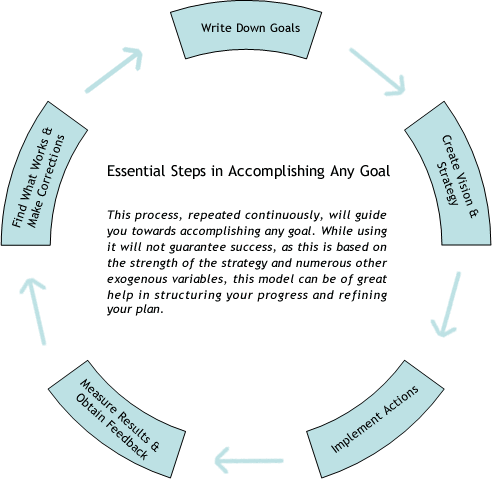The reading level for this article is Moderate
There are six core steps in accomplishing any goal, including that of building a business. These are:
Write Down Goals
Create Vision & Strategy
Implement Actions
Measure Results & Obtain Feedback
Find What Works & Make Mid-Course Correction
Repeat Process
These steps are highlighted in the following diagram.
My last article, “Sync Your Personal Goals with Your Business Goals” helped you complete step one. I explained that you must discern your ability to take risk and match this with your expected return to decide whether to start a lifestyle or high-potential company. You wrote down your goals and can see the endpoint. You know where you want to go.
Now, you need a game plan to get there. You need create a vision and develop your strategy.
As a side note, the remainder of this article will assume that you already have a viable business idea and plan to pursue it. If you are not sure what business your company will be in, yet are still very interested in entrepreneurship, I would suggest going to work in an entrepreneurial company. In a 1989 survey of one hundred the founders of the ‘Inc. 500’ fastest growing private companies, 71% identified ‘replicating or modifying an idea encountered through previous employment.’ Surely this is a also good way to gain experience while you develop your plan. In addition, be sure to read trade magazines of any industries or niches you are in, and pay attention to what you desire but cannot find as a consumer. Sooner or later you’ll have your idea. Then, return to identifying your goals and then creating your vision and strategy.
Once you have your business idea you must ensure you have a well-defined strategy. It must provide a clear direction for the enterprise and describe the market you wish to enter, the potential risks and rewards, the people that will help you get there, and how you are going to get there.
Determining the right level of planning to do can be difficult. You do not want to over-plan, as the opportunity may cease to exist by the time you get to executing, but you do want to have some sort of document that lays out where you want to go and how you will get there.
On the subject of too much versus too little planning, Harvard Business School researcher Amar Bhide states in his article, “How Entrepreneurs Craft Strategies That Work,”
A comprehensive analytical approach to planning does not suite most start-ups. Entrepreneurs typically lack the time and money to interview a representative cross section of potential customers, let alone analyze substitutes, reconstruct competitors’ cost structures, or project alternative technology scenarios. In fact, too much analysis can be harmful; by the time an opportunity is investigated fully, it may no longer exist.
In the end, unless one is seeking outside investment right away or needs a loan from the bank, there is no need to create a full business plan.
Personally, I tend to go by the philosophy of ‘Ready. Fire. Aim.’ I encourage would encourage you to have a bias towards action. There is no use waiting until everything is perfect and lined up before beginning. For instance, imagine waiting to go to work each morning until every single light along the route was green. You’d never get going. The key is to start the movement, the inertia, and get the ball rolling. Thing will generally snowball as you move along the learning curve. You will find new resources, meet new people, and run into new opportunities.
Nevertheless, some planning is surely essential. Bhide goes on to state that all ventures need some level of analysis, planning and strategy development. While you may not need an extensive business plan with the next five years of financials laid out, it is good to have an idea how you plan to reach your goals and what steps you need to take to get started. Commit these things to paper and you’ll be well on your way.
Once the strategy is well-defined, you also should analyze the feasibility of your strategy. In doing so, ask yourself the following questions.
What is the company’s unique selling point(s)? Why would a customer purchase from your company and not another? Potential answers may include 1) a closer location, 2) a better price, 3) a higher quality product, 4) a product no other company has, 5) better information provided to the customer 6) a better marketing process.
What competitive edges, if any, does your company have? Do you have proprietary intellectual property, an exclusive agreement, lower costs, better relations with your supplier, a better product, a better Board of Directors, or better employees?
What is the state of the market? Is it growing? Are there large barriers to entry? How many competitors are there? Will I have enough funding to develop the product, acquire customers, and get to the break even point?
It is always a good idea to align your plan with a current trend, technological development, or regulatory change. Be on the leading edge of a growing market, not at the back end of a shrinking market.
If you can develop a strong unique selling point, create a few competitive edges, and are going into a market that is large and growing, or at least does not have many strong competitors, you will be well on your way to success.
Congratulations. You have now analyzed created your vision and strategy.
Great strategies, however, don’t guarantee great execution. As the saying goes, ideas are a dime a dozen. What really counts is execution. This is where the next step, ‘Implement Actions,’ comes in.


